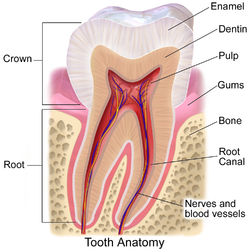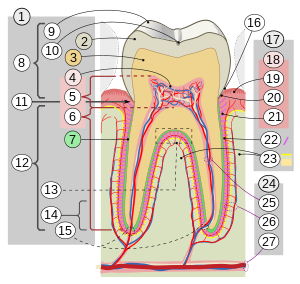Indentistry,crownrefers to theanatomicalarea ofteeth,usually covered byenamel.The crown is usually visible in themouthafterdevelopingbelow thegingivaand theneruptinginto place. If part of the tooth gets chipped or broken, a dentist can apply anartificial crown. Artificial crowns are used most commonly to entirely cover a damaged tooth or to cover an implant. Bridges are also used to cover a space if one or more teeth is missing. They are cemented to natural teeth or implants surrounding the space where the tooth once stood.[1] There are various materials that can be used including a type of cement or stainless steel.[2]The cement crowns look like regular teeth while the stainless steel crowns are silver or gold.
| Crown | |
|---|---|
 Crown labeled at left in image. | |
| Details | |
| Identifiers | |
| Latin | corona dentis |
| MeSH | D019228 |
| TA98 | A05.1.03.009 |
| TA2 | 915 |
| FMA | 55623 |
| Anatomical terminology | |

17.Periodontium
:18.Gingiva:::19. free or interdental::20. marginal::21. alveolar:22.Periodontal ligament:23.Alveolar bone24. Vessels and nerves::25. dental:26. periodontal:27. alveolar through channel
References
edit- ^"Crown and Bridge".Revitalizing Smiles.Archived fromthe originalon 21 July 2018.Retrieved6 June2016.
- ^"American Dental Association Crown and Bridge".Retrieved2013-10-29.
- Ash, Major M. and Stanley J. Nelson.Wheeler’s Dental Anatomy, Physiology, and Occlusion.8th edition. 2003.ISBN0-7216-9382-2.